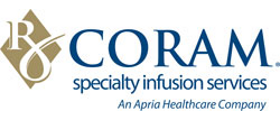Case Study: Coram Infusion

Overview
Coram's new infusion system receives infusion request from hospitals, clinic doctors and Coram field representatives through multiple channels. The first channel takes in faxed requests through fax-to-tiff image capture solution. Multiple request forms can be faxed in together as a batch - Capture automatically triages the batch to split out each form, extracts information and use the retrieved data to either create a new infusion request instance in the system, or attach the request document and data as amendments to an existing request. Then the BPM and Rules engine routes the requests for validation review, and manages them through the approval process. Upon completion of order, all documents are archived through document management system.
The second channel takes incoming calls through an IVR, which identifies the requester based on their phone number and invokes a web service to backend BPM/Rules engine. The BPM/Rules engine looks up the requester in the database and pre-populates a request form, then instructs the IVR to route the call to an available call center agent. The agent receives the call along with the pre-populated infusion request form, and completes the transaction. The rest of the approval and archiving process then follows the same flow as faxed-in requests.
Situation
Coram is a leading provider of specialty infusion and pharmacy distribution services with more than 85 branch locations (including 65 infusion suites) throughout the country. Coram has more than 2,000 employees, including nearly 1,000 infusion nurses and pharmacists that provide services to thousands of home and infusion suite IV patients every day.
Coram's infusion services, which are offered from their branch locations and infusion suites, were initiated through a number of channels but routed through a common process. Patient referrals via fax presented a particular issue. Once received, referral requests would be put on paper and routed through a review and approval process spanning multiple internal organizations. Every process step involved putting the request form into an envelope for delivery to the desktop of the next reviewer. The logistical challenge of tracking down and reporting on the status of any individual request was significant in itself, but became even more difficult when amendment documents had to be attached to these requests mid-stream and re-routed to another workflow. For Coram, a company known in the industry for providing a high level of personalized care, the difficulties in tracking requests and responding quickly to amendment changes were unacceptable.
Solution
Using BPM and Rule engine on top of messaging bus, SaaSafras streamlined the process flow of incoming faxes by replacing the manual, paper-intensive process with an automated electronic workflow. The fax-to-tiff image capture module receives incoming fax requests, extracts data from the form along with meta data such as the source fax number, and stores it in a database. The BPM/Rules engine then uses this information to create a dynamic workflow instance that electronically routes the request for verification. The verifier is presented with both the extracted information and a digitized image of the form. Once verified, BPM/Rules engine dynamically routes the requests by identifying the correct reviewers, routing the forms, notifying reviewers of assigned tasks, and enforcing review business policies. Since the process is electronic, BPM/Rules engine is also able to receive amendment forms, match them to the original request, and reroute the request to a new review process or escalate as needed. In each step, the request footprint is logged. When a request is either approved or denied, the fax image along with key index data are archived into document management system for future reference.
Benefits
For Coram, the benefits of replacing their paper-based process include:
- Faster Service: Review decisions now take hours instead of days.
- Improved Responsiveness: Amendments can be matched and appended to original request automatically. Also, the original request can be re-routed for a different review path automatically based on the content within amendments.
- Better Management and Monitoring: Management and support teams are able to track down and view the status of any request in real-time, and can view the overall performance of the process through a dashboard.
- Better Coordination: Requests can be easily transferred among branches, or between central office and branches, by just a click of the "Submit" button.

